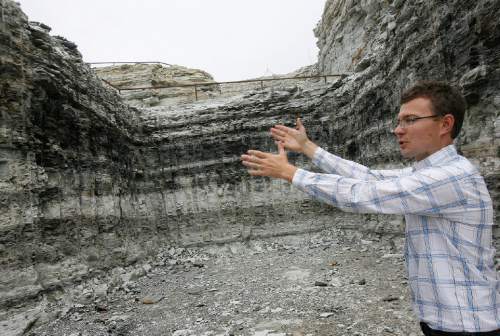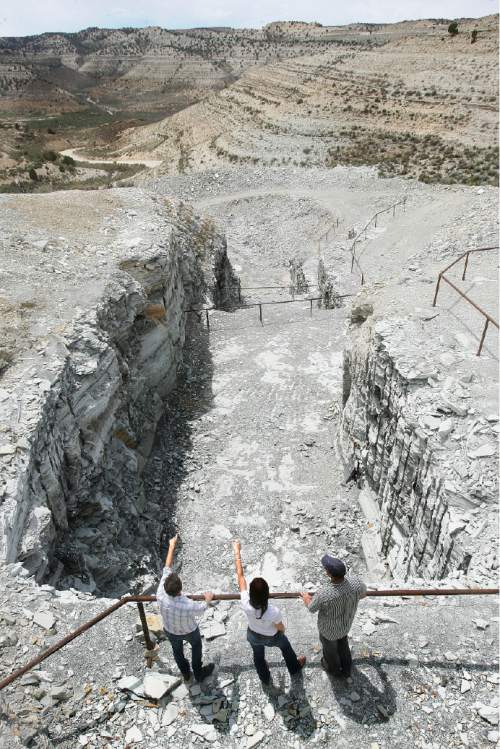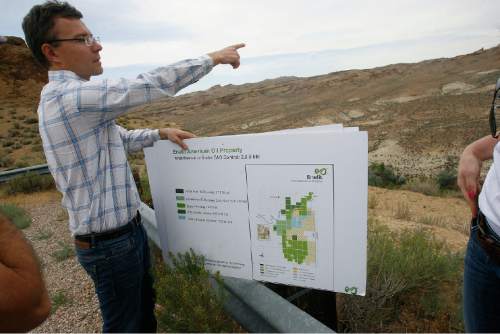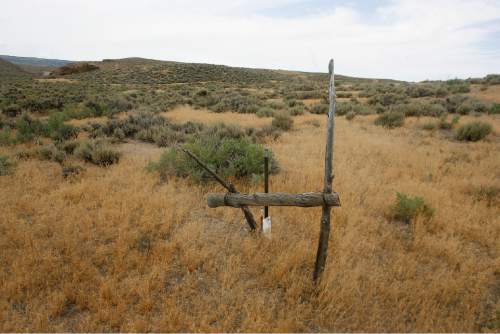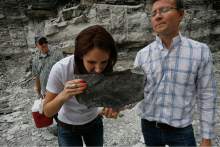This is an archived article that was published on sltrib.com in 2015, and information in the article may be outdated. It is provided only for personal research purposes and may not be reprinted.
Cratering oil prices have slowed Utah's oil-shale business, but the nascent commercial industry is still on its feet, moving forward on projects that proponents hope someday will unlock a vast trove of hydrocarbons embedded under the Uinta Basin.
One of Utah's four major players, Australia-based Ambre Energy, has bowed out, selling its 33,700 acres of state leases to Red Leaf Resources for $4 million.
This Utah firm is closest to becoming North America's first commercial oil-shale producer, but this year, Red Leaf suspended work on its Seep Ridge mine and is re-engineering its retort process that separates oil from rock in an effort to reduce costs, according to remarks that executives made at the Oil Shale Symposium this week in Salt Lake City.
With oil trading near $50 a barrel, Red Leaf was forced to rethink its timeline, Chief Executive Officer Adolph Lechtenberger told conference-goers Tuesday.
"After vigorous debate, we decided the best approach was to significantly slow down our EPS [early production system] construction. It was a painful decision. It had serious implications for our employees, contractors and shareholders, but it was the right decision," he said.
The firm, which has already invested $150 million in partnership with French energy giant Total, will resume full-scale construction on its mine and retort pits in 2017, with production beginning in the back half of 2018, the executive said.
Utah is home to the nation's most promising oil shale deposits that can yield as much as 77 billion barrels, much of it found in a rich "mahogany ledge" formed under large swaths of the Uinta Basin's southern rim.
Oil shale holds a premature hydrocarbon known as kerogen that must be heated to yield liquid oil. The Utah industry is exploring different methods for accomplishing this conversion, a process known as retort.
Red Leaf's technology, which it has licensed to another Uinta Basin developer, "cooks" the ore in constructed pits. Enefit American Oil, by contrast, will run its ore through an industrial plant using retort technology proven by its Estonian parent company, Eesti Energia.
Economics are hardly the industry's only obstacle, with environmentalists actively working to stop oil shale and tar sands development because in most cases these "unconventional" resources require strip mining and heavy processing. Ore would be crushed and heated, scarring the land, leaving huge piles of spent tailings, contaminating the ground and unleashing a climate-disrupting "carbon bomb," opponents allege.
Oil shale should be left in the ground, said John Weisheit of Moab-based Living Rivers.
"A lot of money is being spent for a product and a method that is untested. It seems if they were really energy entrepreneurs, they would spend the money on things that don't strip-mine our lands, diminish our water supplies and affect our air," said Weisheit.
His group is litigating to invalidate Red Leaf's state groundwater permit, arguing its below-grade heating capsules are liable to fail and release chemicals into the ground and air.
Still, Utahns support oil shale development, according to one executive, citing recent survey data. About 84 percent of Uinta Basin residents want to see the region's oil shale developed, said Enefit CEO Rikki Hrenko-Browning.
"We don't have that much support in Estonia where we are [the tiny Baltic nation's] largest employer," Hrenko-Browning said. Enefit is developing a major mine near the Colorado state line that originally envisioned surface mining on private land south of Bonanza, in Uintah County.
Enefit still expects to tap surface deposits, but it has altered its mining plan to shift more quickly to underground mining. The change will allow Enefit to build its retort plant on a site with less-challenging terrain, saving $100 million, Hrenko-Browning said.
The plant's capacity also will be halved, to 280 tons an hour, which would produce 4,000 barrels of oil a day if it operates around the clock.
Meanwhile, the BLM is expected to release a draft Environmental Impact Statement later this year on Enefit's proposed utility corridor across public land. The corridor will deliver water, power and natural gas to the Enefit operation and move crude out through a 16-inch pipe over the 11 miles of badlands.
Last year, Red Leaf dug 400-by-800-foot pits, 150 feet deep, that will house oven-like capsules where ore would be heated over several months. The plan initially called for conveying heat to the ore through a system of steel pipes, which are now piled on-site. Red Leaf has decided to not use pipes, but instead inject hot gas directly into the ore. Processing time would be reduced from 400 to 200 days.
"This change is expected to result in lower heating cost, less heat loss, lower emissions and more oil produced for a given capsule size," Red Leaf's annual report states. "The decrease in heating cycle time would slightly lower the quality of oil produced, but this lost value should be more than offset by increased volumes."
Weisheit, however, wondered whether such changes would be allowed under Red Leaf's current permits.
If implemented, Lechtenberger said, engineering changes could lower Red Leaf's "break-even point" for oil production to between $60 and $80 a barrel. When fully operational, the Seep Ridge project will produce 20,000 to 30,000 barrels a day.


